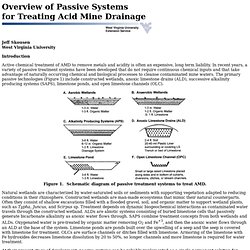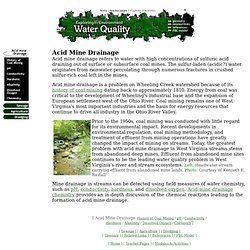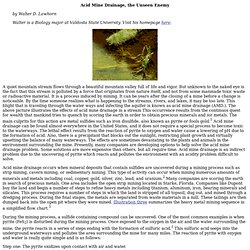

Acid Mine Drainage, Environmental Impact and Waste Rock Dumps. By Jack Caldwell INTRODUCTION There is no one place to access all the information there is on acid rock drainage.

I have no intention of trying to remedy that lack. All I do in this review is present the current state of things as gleaned from the proceedings of the 7th International Conference on Acid Rock Drainage (ICARD) held in March 2006 in St Louis, Missouri. To keep things moving I do not provide paper titles or authors; all I do is provide in square brackets [xxxx] the page number of the paper. As that is the way the CD of the proceedings is organized for quick access, I believe this facilitates your accessing papers. I have not tried to include reference to all the papers; I touch on only those that caught my attention. All 209 pages are now available on-line. INAP. Global ARD Alliance. Objective: Share information and work collaboratively with like organizations across the world. MEND. Objectives: Develop scientifically based technologies to reduce the effects of acid drainage.
ARD at Enviromine Home Page. Overview of Passive Systems for Treating Acid Mine Drainage. Jeff Skousen West Virginia University Introduction Active chemical treatment of AMD to remove metals and acidity is often an expensive, long term liability.

In recent years, a variety of passive treatment systems have been developed that do not require continuous chemical inputs and that take advantage of naturally occurring chemical and biological processes to cleanse contaminated mine waters. The primary passive technologies (Figure 1) include constructed wetlands, anoxic limestone drains (ALD), successive alkalinity producing systems (SAPS), limestone ponds, and open limestone channels (OLC). Figure 1. Natural wetlands are characterized by water-saturated soils or sediments with supporting vegetation adapted to reducing conditions in their rhizosphere. At their present stage of development, passive systems can be reliably implemented as a single permanent solution for many types of AMD and at a much lower cost than active treatment. Figure 2. Natural Wetlands Constructed Wetlands. Forms of Pollution. Acid Mine Drainage Acid mine drainage refers to water with high concentrations of sulfuric acid draining out of surface or subsurface coal mines.

The sulfur-laden (acidic?) Water originates from rainwater percolating through numerous fractures in crushed sulfur-rich coal left in the mines. Acid mine drainage is a problem on Wheeling Creek watershed because of its history of coal mining dating back to approximately 1810. Energy from coal was critical to the development of Wheeling's industrial base and the expansion of European settlement west of the Ohio River.
Coal mining remains one of West Virginia's most important industries and the basis for energy resources that continue to drive all industry in the Ohio River Valley. Prior to the 1950s, coal mining was conducted with little regard for its environmental impact. Mine drainage in streams can be detected using field measures of water chemistry, such as pH, conductivity, hardness, and dissolved oxygen. Acid Mine Drainage, the Unseen Enemy. Acid Mine Drainage, the Unseen Enemy by Walter D.

Lawhorn Walter is a Biology major at Valdosta State University. Visit his homepage here. A quiet mountain stream flows through a beautiful mountain valley full of life and vigor. But unknown to the naked eye is the fact that this stream is polluted by a force that originates from nature itself, and not from some manmade toxic waste or radioactive material. Acid mine drainage occurs when mineral deposits that contain sulfides are uncovered during a mining process such as strip mining, cavern mining, or sedimentary mining. During the mining process, a sulfide containing compound can be uncovered. Step one: The pyrite oxidizes upon contact with air and water. 1) Fe+2 + 1/4 O2 + H+ --> Fe+3 +1/2 H2O Step two: Iron oxidizes to ferric iron 2) FeS2 + 7/2 O2 + H2O --> 2SO4-2 + Fe+2 + 2H+ Step three: Precipitation occurs with ferric iron to ferric hydroxide. 3) Fe+3 + 3H2O --> Fe(OH)3 + 3H+ 4) FeS2 + 15/4 O2 + 7/2 H2O --> 2H2SO4 + Fe(OH)3 4.
DEP > Mining > Abandoned Mine Reclamation > Publications. Acid mine drainage - chemistry.